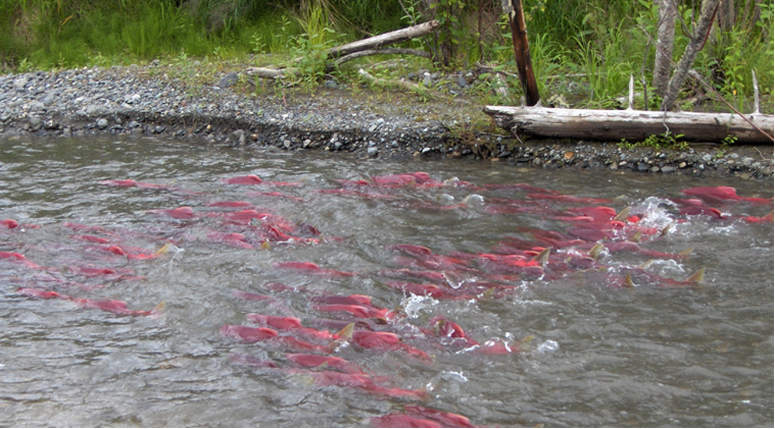
Yentna River
Fish
The Fish
At the Yentna River sonar site, the Alaska Department of Fish and Game sorts through overlapping and abundant runs of chum, sockeye, coho, king and pink salmon to produce estimates for just one species—sockeye salmon. Out of 24 sockeye-producing lakes in the Susitna Drainage, 12 are located in the Yentna Drainage. In the Yentna Drainage, Chelatna, Shell, Hewitt and Judd lakes are believed to be the most productive.
While the Susitna River remains Upper Cook Inlet’s third most productive sockeye salmon drainage, its stocks have been in decline and in 2008 the Board of Fish designated Susitna drainage sockeye salmon a stock of yield concern. Several factors are likely involved in the decline, one of which has alarmed biologists. Invasive northern pike, which prey on juvenile salmon, have been found in 14 of the drainage’s sockeye-producing lakes. Susitna sockeye salmon have not developed defenses to protect themselves from northern pike predation. Also, northern pike most effectively prey on sockeye juveniles in drainages with shallow lake systems, such as the Susitna drainage.

Susitna sockeye salmon are mostly harvested in mixed-stock fisheries by drift and set gillnet fishermen in Upper Cook Inlet. Smaller numbers are also harvested in sport and subsistence fisheries in the Susitna drainage. Using genetic samples from the commercial catch to separate it by stock, biologists estimate Susitna sockeye salmon represent about 5.2 percent of the Upper Cook Inlet sockeye harvest, which averages about 2.9 million fish.
Susitna drainage sockeye management
In January 2009, ADF&G determined the existing Yentna River sockeye salmon escapement goal was inappropriate given the uncertainties associated with sonar site estimates and eliminated it in favor of weir-based goals. The sonar goal was replaced with sustainable escapement goals for sockeye passage past weirs at the outlets of three lakes—Judd and Chelatna Lakes in the Yentna River drainage, and Larson Lake in the mainstem Susitna River drainage. An SEG of 20,000 to 65,000 fish was established for Chelatna Lake, 25,000 to 55,000 for Judd Lake and 15,000 to 50,000 for Larson Lake. Together, Chelatna and Judd lakes are believed to represent about 43 percent of the sockeye salmon production in the Yentna River. Larson Lake is believed to represent about 52 percent of the sockeye salmon production in the Susitna River mainstem.


 Susitna drainage sockeye salmon spend one to two years in freshwater as juveniles and two to three years in the ocean before returning to the river to spawn. Fish lengths vary by river, but generally Upper Cook Inlet sockeye salmon that spend two years in the ocean grow to about 18 to 22 inches and those that spend three years in the ocean grow 20 to 24 inches long. Since 1986, more than 50 percent of Yentna sockeye salmon have been found to return after spending three years in the ocean.
Susitna drainage sockeye salmon spend one to two years in freshwater as juveniles and two to three years in the ocean before returning to the river to spawn. Fish lengths vary by river, but generally Upper Cook Inlet sockeye salmon that spend two years in the ocean grow to about 18 to 22 inches and those that spend three years in the ocean grow 20 to 24 inches long. Since 1986, more than 50 percent of Yentna sockeye salmon have been found to return after spending three years in the ocean. In some years, sockeye salmon are the Yentna River’s most abundant species. But when pink salmon enter the river in large numbers, as they generally do every other year, they typically outnumber sockeye salmon.
In some years, sockeye salmon are the Yentna River’s most abundant species. But when pink salmon enter the river in large numbers, as they generally do every other year, they typically outnumber sockeye salmon.